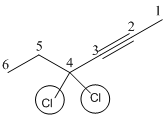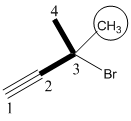
(a)
Interpretation:
The systematic name and IUPAC name of each group substituent in the given molecules should be identified.
Concept introduction:
Any organic molecule can be named by using certain rules given by IUPAC (International Union for Pure and applied chemistry). IUPAC name consists of three parts in major namely Prefix suffix and root word.
Prefix represents the substituent present in the molecule and its position in the root name.
Suffix denotes the presence of
For
Root word represents the longest continuous carbon skeleton of the organic molecule.
Two stereoisomers are there for an alkyne molecule. It depends upon the location of bulky group (or high molecular weight) on the triple bonded carbon atoms. If the bulky groups are in same side then it is cis-isomer. If the bulky groups are in opposite side then it is trans-isomer.
(a)
Answer to Problem 32PP
Answer
The systematic names for the given molecules (a-c) are shown below.
(a). 2,2,5-Trimethyl-3-hexene
Explanation of Solution
The systematic name for the given molecule (a).
Draw the given molecule (a) and find the longest parent carbon chain or carbon skeleton and the substituents for naming the compound.

(a). 2,2,5-Trimethyl-3-hexene
The given molecule is drawn. The parent carbon skeleton is the longest continuous carbon chain that should contain more number of carbons. In the given molecule the parent carbon skeleton is the chain which contains 6 carbons. Hence the root name of the molecule is hexa. Since it is an alkyne with 6 carbons then hexane will be the parent carbon chain name.
The substituents present in the molecule are methyl, bromo (Br) groups on 2 and 5. Therefore on numbering the three methyl groups are present at 2 and 5. Positions is 2,2,5-Trimethyl.
Hence the systematic name for the molecule (a) is 2,2,5-Trimethyl-3-hexene
(b)
Interpretation:
The systematic name and IUPAC name of each group substituent in the given molecules should be identified.
Concept introduction:
Any organic molecule can be named by using certain rules given by IUPAC (International Union for Pure and applied chemistry). IUPAC name consists of three parts in major namely Prefix suffix and root word.
Prefix represents the substituent present in the molecule and its position in the root name.
Suffix denotes the presence of functional group if any in the molecule. It can be an alkene, alkyne, alcohol, carboxylic acid, alcohol etc...
For alkynes molecules, suffix will be ‘yne’.
Root word represents the longest continuous carbon skeleton of the organic molecule.
Two stereoisomers are there for an alkyne molecule. It depends upon the location of bulky group (or high molecular weight) on the triple bonded carbon atoms. If the bulky groups are in same side then it is cis-isomer. If the bulky groups are in opposite side then it is trans-isomer.
(b)
Answer to Problem 32PP
Answer
The systematic names for the given molecules (a-c) are shown below.
(b). 4,4-Dichloro-2-hexene
Explanation of Solution
The systematic name for the given structure (b).
Draw the given molecule (b) and find the longest parent carbon chain or carbon skeleton and the substituents.

4,4-Dichloro-2-hexyne
The given molecule is drawn. The parent carbon skeleton is the longest continuous carbon chain that should contain six carbon atoms.
In the given molecule the parent carbon skeleton is linear in nature which consistes of 6 carbons so the root word for the molecule is 4,4- Dichloro-2-hexyne. The suffix ‘yne’ is used since it is an alkyne.
The substituent present in the molecule are 2-chloro atoms in C4 carbon.
Hence the systematic name for the molecule (b) is 4,4-Dichloro-2-hexyne.
(c)
Interpretation:
The systematic name and IUPAC name of each group substituent in the given molecules should be identified.
Concept introduction:
Any organic molecule can be named by using certain rules given by IUPAC (International Union for Pure and applied chemistry). IUPAC name consists of three parts in major namely Prefix suffix and root word.
Prefix represents the substituent present in the molecule and its position in the root name.
Suffix denotes the presence of functional group if any in the molecule. It can be an alkene, alkyne, alcohol, carboxylic acid, alcohol etc...
For alkynes molecules, suffix will be ‘yne’.
Root word represents the longest continuous carbon skeleton of the organic molecule.
Two stereoisomers are there for an alkyne molecule. It depends upon the location of bulky group (or high molecular weight) on the triple bonded carbon atoms. If the bulky groups are in same side then it is cis-isomer. If the bulky groups are in opposite side then it is trans-isomer.
(c)
Answer to Problem 32PP
Answer
The systematic names for the given molecules (a-c) are shown below.
(c). 1-Hexyne
Explanation of Solution
The systematic name for the given structure (c).
Draw the given molecule (d) and find the longest parent carbon chain or carbon skeleton and the substituents.

1-Hexyne
The given molecule is drawn. The parent carbon skeleton is the longest continuous carbon chain that should contain more number of carbons. In the given molecule the parent carbon skeleton is linear in nature which consists of 6 carbons so that root word for the molecule is 1-Hexyne. The suffix ‘yne’ is used since it is an alkyne.
The parent chain is numbered so that the triple bond is assigned the lowest possible locate (1 indicates that the the triple bond is located between C1 and C2).
Hence the systematic name for the molecule (c) is 1-Hexyne.
(d)
Interpretation:
The systematic name and IUPAC name of each group substituent in the given molecules should be identified.
Concept introduction:
Any organic molecule can be named by using certain rules given by IUPAC (International Union for Pure and applied chemistry). IUPAC name consists of three parts in major namely Prefix suffix and root word.
Prefix represents the substituent present in the molecule and its position in the root name.
Suffix denotes the presence of functional group if any in the molecule. It can be an alkene, alkyne, alcohol, carboxylic acid, alcohol etc...
For alkynes molecules, suffix will be ‘yne’.
Root word represents the longest continuous carbon skeleton of the organic molecule.
Two stereoisomers are there for an alkyne molecule. It depends upon the location of bulky group (or high molecular weight) on the triple bonded carbon atoms. If the bulky groups are in same side then it is cis-isomer. If the bulky groups are in opposite side then it is trans-isomer.
(d)
Answer to Problem 32PP
Answer
The systematic names for the given molecules (a-c) are shown below.
(d). 3-Bromo-3-methyl-1-butyne
Explanation of Solution
The systematic name for the given structure (d).
Draw the given molecule (d) and find the longest parent carbon chain or carbon skeleton and the substituents for naming the compound.

3-Bromo-3-methyl-1-butyne
The given molecule is drawn. The parent carbon skeleton is the continuous carbon chain that should contain more number of carbons. In the given molecule the parent carbon skeleton is the chain which contains 4 carbons. Hence the root name of the molecule is butane. Since it is an alkene with 4 carbons then butyne will be the parent carbon chain name.
In the given molecule parent chain is numbered so that the triple bond assigned the lowest possible locate (1 indicates that the triple bond is located between C1 and C2). The one methyl group, one bromo groups are present at C3 positions is 3-Bromo-3-methyl (The alphabetized in the name, Br and CH3).
Hence the systematic name for the molecule (a) is 3-Bromo-3-methyl-1-butyne.
Want to see more full solutions like this?
Chapter 9 Solutions
ORGANIC CHEMISTRY 1 TERM ACCESS
- Can you explain how I get these here and show the steps plz?arrow_forwardGive the IUPAC name for this compound Hydrocarbon Condensed Formulas Hint C2H5 CH2CH3 expand that in all the formula Part A: (CH3)2CHCH(C2H5)CH2CH2CH3 Give the IUPAC name for this compound. Part B: CH2=C(C2H5)CH2CH2CH3 Give the IUPAC name for this compound. Part C: (CH3)2C=CHC(C2H5)=CH2 Give the IUPAC name for this compound. Part D: CH3C=CCH(C2H5)2 Give the IUPAC name for this compound. Part E: (CH3)3CC=CCH2CH=C(CH3)2arrow_forwardSelect/ Match the correct letter from the image below for the IUPAC names given below: A B C D 3 E F G H K L Part 1. 4-methylheptane For example.mmmm Answer Letter H _for part 1 Part 2. 2,4-dimethylhexane Part 3. 2,3-dimethylpentane Part 4. 2,2-dimethylhexane Part 5. 2-ethyl-1,1,3,3-tetramethylcyclopentane Part 6. 3-ethyl-2-methylpentanearrow_forward
- Can u show the process as to how to get these?arrow_forwardSketch the expected 'H NMR spectra for the following compound. Label all of the H's in the structure and the corresponding signal for the spectra you sketch. Make sure you include the integration value and the splitting pattern for each signal Indicate how many signals you would expect in the 13C NMRarrow_forwardUse IUPAC naming rules to name the following hydrocarbon compounds: CH2-CH3 | a) CH-CH-CH2-CH-CH-CH3 b) | CH2 CH3 | CH3 CH3 \ / C=C H 1 H CH2-CH3 c) d) CH=C-CH3 e) CH3-CH2-CH2-CH=CH-CH3 f) CH2=CH-CH2-CH=CH-CH3 g) CH3-CH2-C = C-CH2-CH3 h)arrow_forward
- Q5 Name the following : a. b. C. d. e.arrow_forward25. Predict the major product of the following reaction. 1 equivalent of each of the starting materials was used. H₂C CH3 CH3 H3C H3C H3C. CH2 + H3C. heat CH3 CH H.C. CH3 H.C H.C CH3 CH CH3 CH3 A B C Earrow_forwardFind chemical structures based on the below information. a) Chemical formula C6H8O Compound is aromatic plus has two 1H NMR peaks that integrated for 3 each that are singlets (it could have more peaks in the 1H NMR b) Chemical Formula: C6H100 Compounds is conjugated 'H NMR has a signal that integrates for 6 and is a doublet IR spectra has a signal at 1730 cm-1arrow_forward
- Jaslev Propose a synthesis of the following starting from benzene and any other reagents and chemicals. No mechanisms are required. Indicate the condition for each step plus the major product for each step. More than two steps are required. Step 1 Step 2 مہد Brarrow_forwardPart C: The line formula for another branched alkane is shown below. i. In the IUPAC system what is the root or base name of this compound? ii. How many alkyl substituents are attached to the longest chain? iii. Give the IUPAC name for this compound.arrow_forwardPart D: Draw the Structural Formula for 4-ethyl-2-methylhexane Part E. Draw the Structural Formula for 1-chloro-3,3-diethylpentane (Chloro = Cl)arrow_forward
 ChemistryChemistryISBN:9781305957404Author:Steven S. Zumdahl, Susan A. Zumdahl, Donald J. DeCostePublisher:Cengage Learning
ChemistryChemistryISBN:9781305957404Author:Steven S. Zumdahl, Susan A. Zumdahl, Donald J. DeCostePublisher:Cengage Learning ChemistryChemistryISBN:9781259911156Author:Raymond Chang Dr., Jason Overby ProfessorPublisher:McGraw-Hill Education
ChemistryChemistryISBN:9781259911156Author:Raymond Chang Dr., Jason Overby ProfessorPublisher:McGraw-Hill Education Principles of Instrumental AnalysisChemistryISBN:9781305577213Author:Douglas A. Skoog, F. James Holler, Stanley R. CrouchPublisher:Cengage Learning
Principles of Instrumental AnalysisChemistryISBN:9781305577213Author:Douglas A. Skoog, F. James Holler, Stanley R. CrouchPublisher:Cengage Learning Organic ChemistryChemistryISBN:9780078021558Author:Janice Gorzynski Smith Dr.Publisher:McGraw-Hill Education
Organic ChemistryChemistryISBN:9780078021558Author:Janice Gorzynski Smith Dr.Publisher:McGraw-Hill Education Chemistry: Principles and ReactionsChemistryISBN:9781305079373Author:William L. Masterton, Cecile N. HurleyPublisher:Cengage Learning
Chemistry: Principles and ReactionsChemistryISBN:9781305079373Author:William L. Masterton, Cecile N. HurleyPublisher:Cengage Learning Elementary Principles of Chemical Processes, Bind...ChemistryISBN:9781118431221Author:Richard M. Felder, Ronald W. Rousseau, Lisa G. BullardPublisher:WILEY
Elementary Principles of Chemical Processes, Bind...ChemistryISBN:9781118431221Author:Richard M. Felder, Ronald W. Rousseau, Lisa G. BullardPublisher:WILEY





